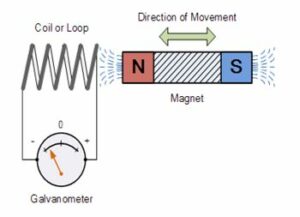Table of Contents
Michael Faraday discovered electromagnetic induction in 1831, and James Clerk Maxwell mathematically described it as Faraday’s law of induction. Electromagnetic induction is the generation of a current as a result of voltage generation (electromotive force) caused by a changing magnetic field. This occurs when a conductor is placed in a moving magnetic field (when using an alternating current power source) or when a conductor is constantly moving in a stationary magnetic field. Michael Faraday set up a conducting wire as shown below, attached to a device that measured the voltage across the circuit. The voltage detector measures the voltage in the circuit when a bar magnet is moved through the coiling.
Michael Faraday discovered this law of electromagnetic induction. He set up a lead wire according to the diagram below, which he connected to a device that measured the voltage across the circuit. When a bar magnet passes through the snaking, the voltage in the circuit is measured. The significance of this is that it is a method of producing electrical energy in a circuit by using magnetic fields rather than batteries. Machines such as generators, transformers, and motors operate on the principle of electromagnetic induction.

Based on his experiments, we now have Faraday’s law, which states that the amount of voltage induced in a coil is proportional to the number of turns and the rate at which the magnetic field changes.
- The operation of an alternating current generator is governed by the principle of electromagnetic induction
- The electromagnetic induction principle underpins the operation of electrical transformers.
- The electromagnetic induction principle underpins the magnetic flow metre.
Question: In a nonuniform magnetic field, a metallic loop is placed. Is there going to be an emf in the loop?
Solution:
There will be no induced emf if the flux through the loop does not change. The magnetic flux through the loop will not change because the magnetic field is non-uniform and does not change with time. As a result, no emf will be induced in the loop.
Question: If a moving-coil galvanometer’s coil is deflected and released, it will continue to oscillate for a long time. When the coil’s ends are connected, the oscillation comes to an abrupt halt. Explain.
Solution:
When the coil’s ends are not connected, it acts as an inductor, causing oscillations to persist until the current slowly decays. When these ends are connected, the coil forms a close loop, creating inductance across the ends and causing the coil to behave differently than an inductor. As a result, all oscillations come to a halt at the same time.
FAQs
What is the source of electromagnetism?
Electromagnetic induction is the technical term for the phenomenon in which an electric current flows in a wire when it is moved near a magnet or when a magnet is moved near a wire.
Q. What is electromagnetic induction and how does it work?
Ans: Electromagnetic induction, also known as induction, is a process in which a conductor is placed in a specific position and the magnetic field varies, or the magnetic field is stationary and the conductor moves.
This causes a voltage or EMF (Electromotive Force) to be generated across the electrical conductor.





